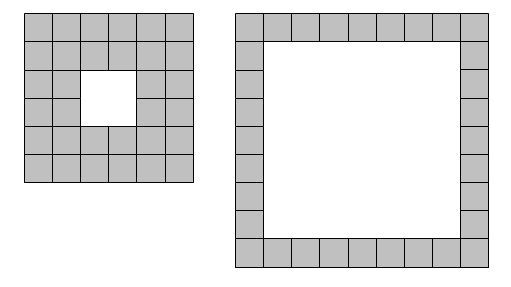Problem 174
Counting the number of “hollow” square laminae that can form one, two, three, … distinct arrangements
We shall define a square lamina to be a square outline with a square “hole” so that the shape possesses vertical and horizontal symmetry.
Given eight tiles it is possible to form a lamina in only one way: 3x3 square with a 1x1 hole in the middle. However, using thirty-two tiles it is possible to form two distinct laminae.

If t represents the number of tiles used, we shall say that t = 8 is type L(1) and t = 32 is type L(2).
Let N(n) be the number of t ≤ 1000000 such that t is type L(n); for example, N(15) = 832.
What is ∑ N(n) for 1 ≤ n ≤ 10?
能组成一种、两种、三种……不同方形基板的地砖数计数
我们定义一个方形基板为一个拥有方形外框,中间有一个方形的“洞”且在水平和竖直方向上均对称的图形。
用八块地砖我们只能拼出一种方形基板:一个3x3的方格,正中间有一个1x1的洞。然而,用32块地砖,我们能够拼出两种不同的方形基板。

如果用t代表使用的地砖数,我们称t = 8是L(1)型的,而t = 32是L(2)型的。
记N(n)为满足t ≤ 1000000且为L(n)型的t的个数;例如,N(15) = 832。
对于1 ≤ n ≤ 10,求∑ N(n)。